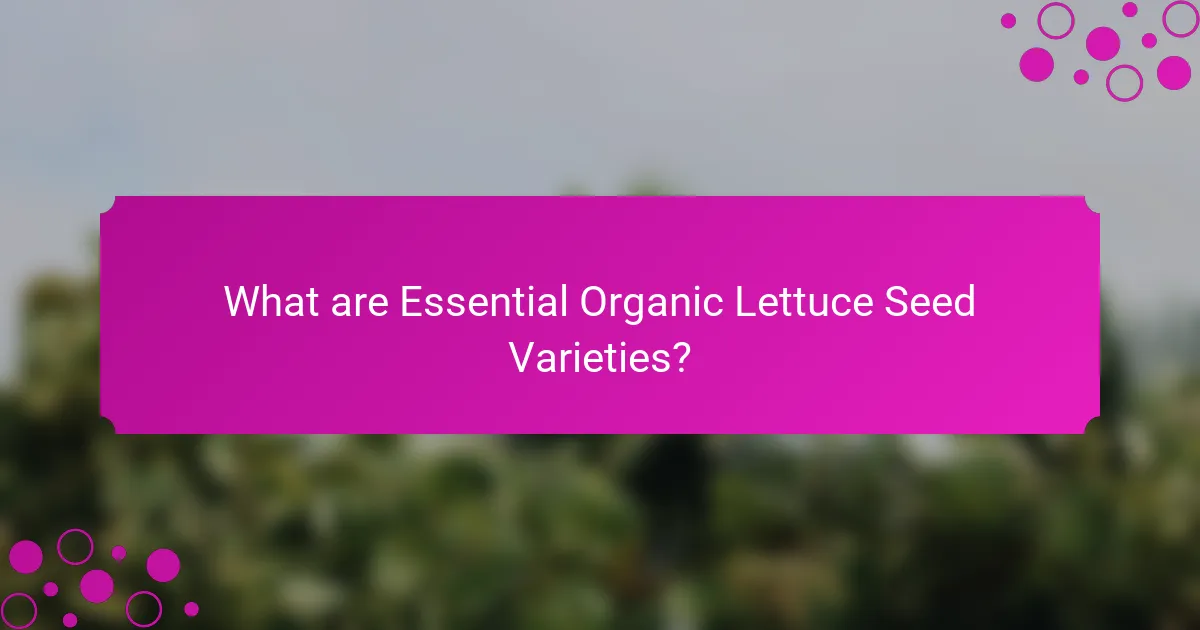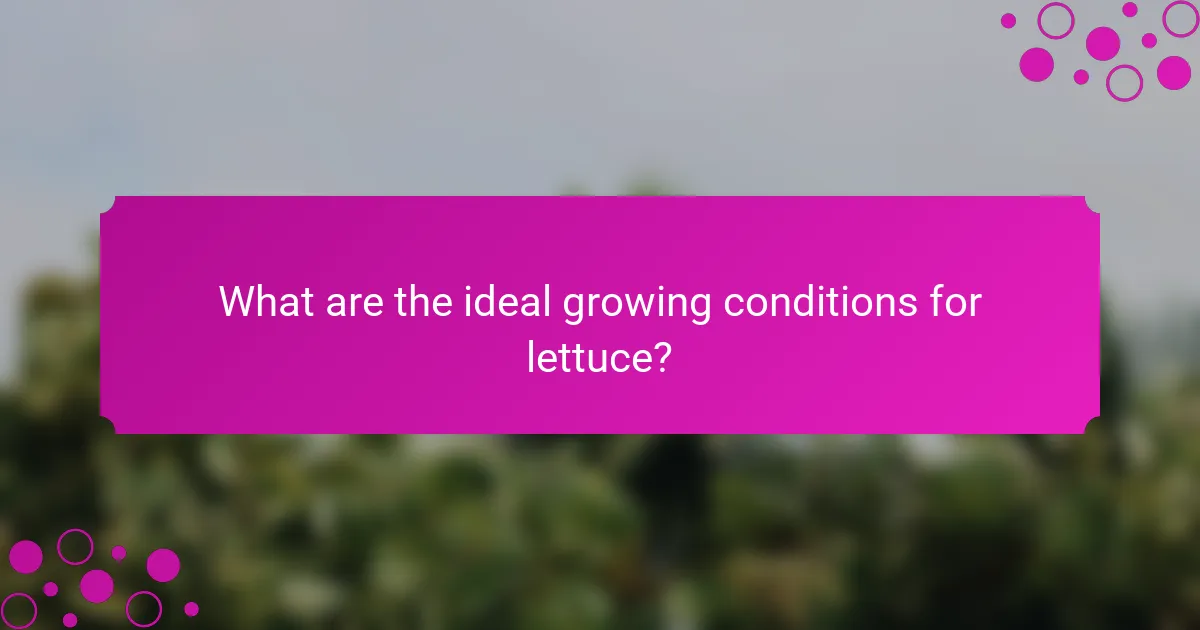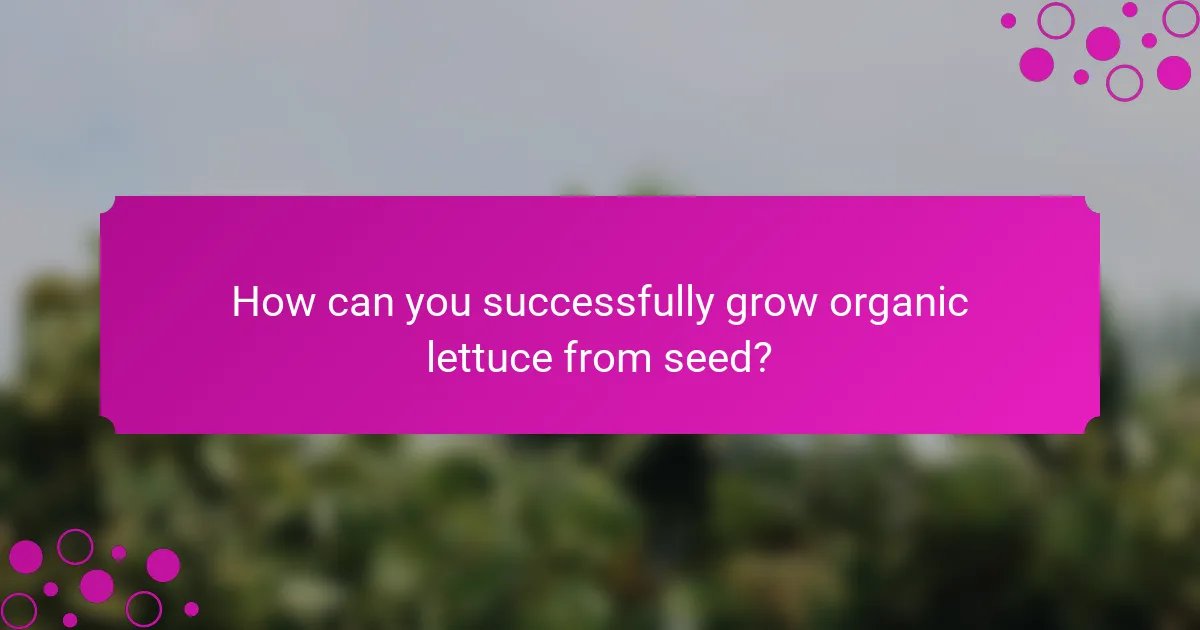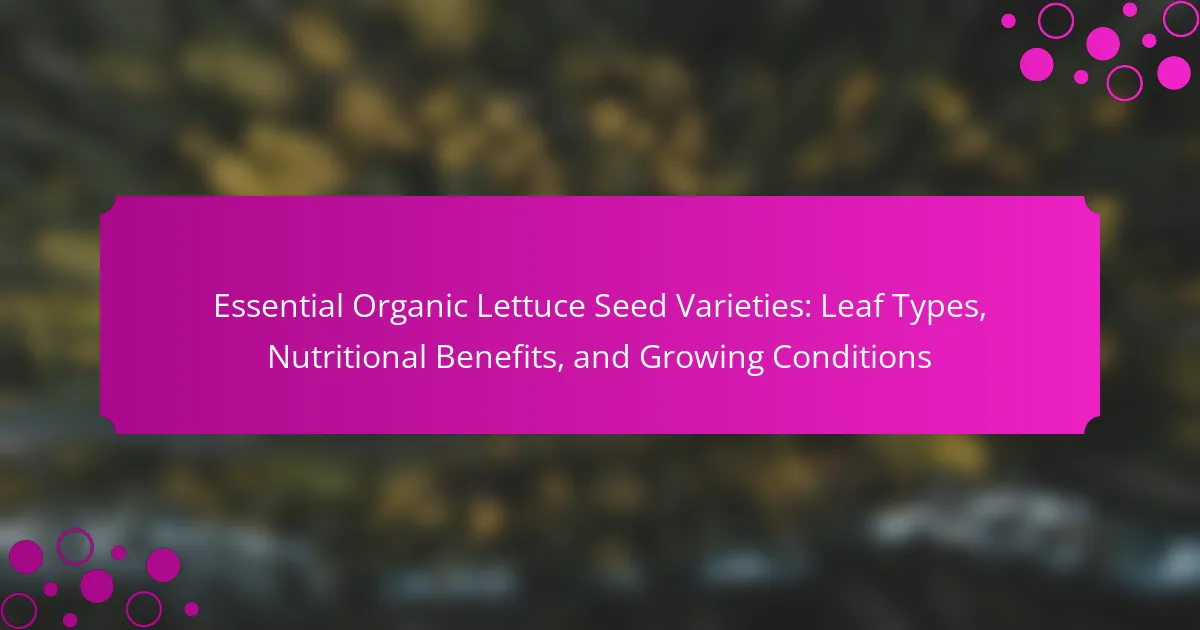The article focuses on essential organic lettuce seed varieties, including Butterhead, Romaine, Leaf, and Crisphead. Each variety offers unique characteristics, such as Butterhead’s tender leaves and sweet flavor, Romaine’s crunchy texture, and the diverse flavors of Leaf lettuces. Crisphead, commonly known as Iceberg, features dense, crunchy leaves. The article details optimal growing conditions for organic lettuce, emphasizing temperature, soil requirements, and moisture levels. It also outlines best practices for planting, caring for, and harvesting organic lettuce to ensure a successful crop.

What are Essential Organic Lettuce Seed Varieties?
Essential organic lettuce seed varieties include Butterhead, Romaine, Leaf, and Crisphead. Butterhead lettuce is known for its tender leaves and sweet flavor. Romaine lettuce has a crunchy texture and is often used in salads. Leaf lettuce varieties come in various colors and shapes, offering a diverse range of flavors. Crisphead lettuce, commonly known as Iceberg, is characterized by its dense, crunchy leaves. These varieties are popular among organic gardeners for their adaptability and taste. Organic seeds ensure that the plants are grown without synthetic pesticides or fertilizers.
How do different leaf types impact lettuce cultivation?
Different leaf types impact lettuce cultivation by influencing growth rates, pest resistance, and yield. Leaf types include romaine, butterhead, and loose-leaf varieties. Romaine lettuce typically grows upright and has a longer harvest period. This variety is known for its resistance to bolting, which allows for extended cultivation. Butterhead lettuce has a softer texture and is more sensitive to temperature fluctuations. This sensitivity can affect its growth in varying climates. Loose-leaf varieties grow quickly and can be harvested multiple times. They are often more tolerant of pests and diseases, making them easier to cultivate in organic systems. Research shows that diverse leaf types can enhance biodiversity in crop rotations, leading to healthier soil and improved yields.
What are the characteristics of leaf lettuce varieties?
Leaf lettuce varieties are characterized by their loose, tender leaves and diverse colors. These varieties typically have a mild flavor and a crisp texture. Common colors include green, red, and purple, providing visual appeal. Leaf lettuce grows quickly, often maturing in 30 to 60 days. It is suitable for cooler climates and can tolerate light frost. Nutritionally, leaf lettuce is low in calories and high in vitamins A and K. Varieties such as Butterhead and Romaine exhibit unique leaf shapes and sizes. Butterhead has soft, rounded leaves, while Romaine features sturdy, elongated leaves.
How do romaine and butterhead differ in growth requirements?
Romaine and butterhead lettuce differ in their growth requirements primarily in temperature and spacing. Romaine thrives in cooler temperatures, ideally between 60°F to 70°F. It requires more space, typically 12 to 18 inches apart for optimal growth. Butterhead, on the other hand, prefers slightly warmer conditions, around 65°F to 75°F. It can be planted closer together, usually 8 to 12 inches apart. These differences affect their overall growth rates and the conditions needed for successful cultivation.
Why is selecting the right seed variety important?
Selecting the right seed variety is crucial for successful crop production. The appropriate seed variety influences yield, disease resistance, and growth conditions. Different varieties have specific attributes that suit particular climates and soil types. For instance, certain lettuce varieties thrive in cooler temperatures while others prefer warmth. Selecting the right variety ensures optimal growth and minimizes resource waste. Research indicates that choosing suitable seed can increase yields by up to 30%. This highlights the importance of making informed decisions based on local growing conditions.
What factors should be considered when choosing lettuce seeds?
When choosing lettuce seeds, consider the climate suitability. Different lettuce varieties thrive in specific temperature ranges. For example, leaf lettuce grows well in cooler conditions, while romaine prefers warmer temperatures.
Next, evaluate the growth duration. Some varieties mature faster than others. Fast-growing types can be harvested within 30 days, while others may take up to 75 days.
Seed type is also crucial. Organic seeds are often preferred for health and sustainability reasons. Non-GMO seeds ensure no genetic modifications have been made.
Look at disease resistance. Certain lettuce varieties are bred to resist common pests and diseases. This can lead to higher yields and less reliance on chemical treatments.
Finally, consider the intended use. Varieties differ in flavor and texture. Some are better for salads, while others are suited for cooking.
How do climate and soil conditions affect seed selection?
Climate and soil conditions significantly influence seed selection for lettuce. Different lettuce varieties thrive in specific temperature ranges. For example, romaine prefers cooler climates, while butterhead can tolerate warmer conditions. Soil type also plays a crucial role. Lettuce grows best in well-drained, loamy soil with a pH of 6.0 to 7.0. Additionally, moisture levels impact seed viability. Excessive moisture can lead to seed rot, while insufficient moisture can hinder germination. These factors guide farmers in choosing appropriate seed varieties for optimal growth and yield.
What nutritional benefits do organic lettuce varieties provide?
Organic lettuce varieties provide essential nutrients that support overall health. They are low in calories and high in water content, promoting hydration. Organic lettuce is a good source of vitamins A, C, and K. These vitamins play vital roles in vision, immune function, and blood clotting. Additionally, organic lettuce contains dietary fiber, aiding digestion and promoting gut health. Antioxidants found in organic lettuce, such as flavonoids, help combat oxidative stress. Studies indicate that organic produce may have higher antioxidant levels compared to conventionally grown varieties. This enhances the nutritional profile of organic lettuce, making it a valuable addition to a balanced diet.
What vitamins and minerals are abundant in lettuce?
Lettuce is abundant in vitamins A, K, and C, as well as minerals like potassium and folate. Vitamin A supports vision and immune function. Vitamin K is essential for blood clotting and bone health. Vitamin C acts as an antioxidant and aids in collagen production. Potassium helps regulate blood pressure and fluid balance. Folate is crucial for DNA synthesis and repair. These nutrients contribute to lettuce’s status as a nutritious leafy green.
How do organic varieties compare to conventional ones nutritionally?
Organic varieties generally have similar nutritional profiles to conventional ones. However, some studies indicate organic produce may have slightly higher levels of certain nutrients. For example, organic lettuce can contain more vitamin C and antioxidants. A study published in the Journal of Agricultural and Food Chemistry found that organic crops often have higher polyphenol content. Polyphenols are associated with numerous health benefits. Additionally, organic farming avoids synthetic pesticides and fertilizers, which may contribute to overall food quality. A meta-analysis in the British Journal of Nutrition reported that organic produce had higher antioxidant activity. These factors can enhance the nutritional value of organic varieties compared to conventional ones.

What are the ideal growing conditions for lettuce?
Lettuce thrives in cool temperatures and well-drained soil. The ideal temperature range for growing lettuce is between 60°F to 70°F. Lettuce prefers a soil pH of 6.0 to 6.8. It requires consistent moisture but should not be waterlogged. Full sun exposure is beneficial, with at least 6 hours of sunlight per day. Fertile soil enriched with organic matter promotes healthy growth. Adequate spacing between plants ensures proper air circulation. These conditions lead to optimal growth and yield.
How does temperature influence lettuce growth?
Temperature significantly influences lettuce growth. Optimal temperatures for lettuce are between 60°F to 70°F (15°C to 21°C). At these temperatures, lettuce grows quickly and develops a tender texture. High temperatures above 75°F (24°C) can cause bolting, leading to bitter leaves. Conversely, low temperatures below 40°F (4°C) can stunt growth and affect seed germination. Research indicates that lettuce exposed to extreme temperatures shows reduced yield and quality. Temperature affects photosynthesis rates, impacting growth and development. Maintaining suitable temperature conditions is crucial for healthy lettuce production.
What are the optimal temperature ranges for different lettuce types?
Lettuce types have specific optimal temperature ranges for growth. Generally, most lettuce varieties thrive between 60°F to 70°F (15°C to 21°C). Butterhead lettuce prefers temperatures around 65°F to 70°F (18°C to 21°C). Romaine lettuce grows best at slightly cooler temperatures, ideally 60°F to 65°F (15°C to 18°C). Leaf lettuce varieties can tolerate a broader range, flourishing between 55°F to 75°F (13°C to 24°C).
Heat-resistant varieties, such as Butterhead, can withstand temperatures up to 75°F (24°C) without bolting. Conversely, temperatures above 80°F (27°C) can cause most lettuce types to bolt prematurely. These temperature preferences are critical for optimal growth and yield.
How can temperature fluctuations affect lettuce yield?
Temperature fluctuations can significantly impact lettuce yield. Lettuce is sensitive to temperature changes, which can affect its growth and development. High temperatures can lead to bolting, where the plant flowers prematurely, reducing yield. Low temperatures can slow growth and increase susceptibility to diseases. Research indicates that optimal temperatures for lettuce growth range between 60°F and 70°F. Outside this range, yields can decline. Studies show that consistent temperatures lead to better quality and quantity of lettuce. Thus, managing temperature is crucial for maximizing lettuce yield.
What soil conditions are best for growing lettuce?
Lettuce grows best in well-draining, loamy soil with a pH of 6.0 to 7.0. This soil type retains moisture while allowing excess water to drain away. Adequate organic matter enhances soil structure and nutrient availability. Lettuce benefits from rich soil that is high in nitrogen. The ideal soil temperature for germination is between 60°F to 70°F (15°C to 21°C). Consistent moisture is crucial, but overwatering can lead to root rot. These conditions promote healthy growth and high-quality yields.
What soil types support healthy lettuce growth?
Lettuce grows best in well-draining, loamy soil. Loamy soil has a balanced mixture of sand, silt, and clay. This composition allows for good aeration and moisture retention. Lettuce prefers a soil pH between 6.0 and 7.0. This pH range supports nutrient availability. Organic matter, such as compost, enhances soil fertility. Sandy soils can also support lettuce but may require more frequent watering. Heavy clay soils can hinder growth due to poor drainage.
How can soil pH and nutrients be optimized for lettuce?
To optimize soil pH and nutrients for lettuce, maintain a pH level between 6.0 and 7.0. This pH range enhances nutrient availability. Test soil regularly to monitor pH levels. Amend soil with lime to raise pH or sulfur to lower it. Incorporate organic matter, such as compost, to improve nutrient content. Lettuce requires nitrogen, phosphorus, and potassium for optimal growth. Use balanced fertilizers that provide these key nutrients. A soil test can guide specific nutrient requirements. Consistent watering supports nutrient absorption and pH stability.
What watering and light requirements should be met?
Lettuce requires consistent watering and adequate light for optimal growth. Watering should keep the soil consistently moist but not waterlogged. This typically means watering about 1 inch per week, depending on weather conditions. Lettuce thrives in full sun, needing at least 6 to 8 hours of direct sunlight daily. Insufficient light can lead to leggy growth and poor flavor. Proper watering and light conditions are essential for healthy, vibrant lettuce plants.
How often should lettuce be watered for optimal growth?
Lettuce should be watered consistently, ideally every 2 to 3 days. This frequency helps maintain soil moisture for optimal growth. Lettuce thrives in moist soil but does not like to be waterlogged. Overwatering can lead to root rot, while underwatering can cause wilting. The ideal soil moisture level should be kept consistently damp, especially during warm weather. Studies show that lettuce requires about 1 to 1.5 inches of water per week. Monitoring soil moisture with a finger test can help determine when to water.
What light conditions are necessary for healthy lettuce plants?
Lettuce plants require full sunlight for optimal growth. They thrive best in 12 to 16 hours of light per day. Insufficient light can lead to leggy growth and poor leaf development. Ideal light conditions include bright, indirect sunlight or artificial grow lights. Lettuce prefers a temperature range of 60 to 70 degrees Fahrenheit during daylight hours. Studies indicate that adequate light enhances chlorophyll production, which is crucial for photosynthesis. This process directly impacts the plant’s health and yield. Therefore, providing sufficient light is essential for growing healthy lettuce.

How can you successfully grow organic lettuce from seed?
To successfully grow organic lettuce from seed, start by selecting high-quality organic seeds. Prepare the soil by ensuring it is well-draining and rich in organic matter. Plant seeds about 1/4 inch deep and 1 inch apart in rows. Water the seeds gently to keep the soil moist but not soggy. Provide adequate sunlight, aiming for at least 6 hours of direct light daily. Thin seedlings to 6-12 inches apart once they are a few inches tall to allow for proper growth. Fertilize with organic compost every few weeks to support healthy development. Monitor for pests and diseases, using organic methods for control. Harvest lettuce when leaves are young and tender for the best flavor. These steps ensure a successful organic lettuce crop.
What are the best practices for planting lettuce seeds?
The best practices for planting lettuce seeds include selecting the right variety, preparing the soil, and ensuring proper spacing. Choose a lettuce variety suited for your climate. Lettuce prefers well-drained, nutrient-rich soil with a pH of 6.0 to 6.8. Prepare the soil by tilling and adding organic matter like compost. Plant seeds about ¼ to ½ inch deep. Space seeds 1 to 2 inches apart to allow for growth. Water the seeds gently to avoid displacing them. Keep the soil consistently moist but not soggy. Lettuce germinates best in cooler temperatures, ideally between 60°F and 70°F. Following these practices leads to healthier plants and better yields.
How deep should lettuce seeds be planted?
Lettuce seeds should be planted about 1/8 to 1/4 inch deep. This shallow planting allows for optimal germination. Lettuce seeds require light for germination, hence the shallow depth is crucial. According to gardening experts, planting too deep can hinder seed sprouting. Consistent moisture is also important during the germination phase. Keeping the soil moist but not waterlogged supports healthy growth.
What spacing is recommended for different lettuce varieties?
Lettuce varieties require specific spacing to thrive. Leaf lettuce should be spaced 6 to 12 inches apart. Head lettuce needs 12 to 18 inches between plants. Romaine lettuce typically requires 12 to 18 inches of spacing as well. Butterhead varieties benefit from 12 to 18 inches apart. These spacing recommendations allow for proper air circulation and nutrient access. Research shows that adequate spacing reduces competition for resources. This leads to healthier plants and better yields.
What common challenges might arise when growing lettuce?
Common challenges when growing lettuce include pests, diseases, and environmental factors. Pests such as aphids and slugs can damage the plants. Diseases like downy mildew and lettuce drop can affect crop yield. Environmental factors include temperature fluctuations and insufficient moisture. Lettuce thrives in cool weather, so high temperatures can cause bolting. Poor soil quality may also hinder growth. Additionally, inadequate sunlight can lead to weak plants. These challenges can reduce the overall quality and quantity of the harvest.
How can pests and diseases affect lettuce cultivation?
Pests and diseases can significantly reduce lettuce yields and quality. Common pests include aphids, slugs, and caterpillars, which damage leaves and stems. Diseases such as downy mildew and lettuce drop can cause wilting and decay. Infected plants may show stunted growth and discoloration. The presence of pests often leads to secondary infections, compounding the damage. According to the University of California Agriculture and Natural Resources, pest and disease management is crucial for maintaining healthy lettuce crops. Effective practices include crop rotation and the use of resistant varieties. These strategies help minimize the impact of pests and diseases on lettuce cultivation.
What are effective organic solutions for managing lettuce issues?
Effective organic solutions for managing lettuce issues include crop rotation, companion planting, and organic pest control methods. Crop rotation helps prevent soil nutrient depletion and reduces disease incidence. Companion planting, such as planting marigolds alongside lettuce, can deter pests. Organic pest control methods include using neem oil or insecticidal soap to manage aphids and other pests. Additionally, maintaining proper soil moisture and using mulch can help prevent lettuce diseases like downy mildew. These strategies are supported by sustainable agriculture practices that emphasize ecosystem balance and soil health.
What tips can ensure a successful lettuce harvest?
To ensure a successful lettuce harvest, select the right variety for your climate. Leafy varieties thrive in cooler temperatures, while romaine prefers moderate warmth. Prepare the soil by enriching it with organic matter to enhance nutrient content. Maintain consistent moisture levels, as lettuce requires regular watering for optimal growth. Implement crop rotation to prevent soil-borne diseases and pests. Monitor for pests like aphids and slugs, and manage them promptly. Harvest lettuce in the morning for crispness and freshness. According to the USDA, proper care can increase yield by up to 50%.
How can you determine the right time to harvest lettuce?
Harvest lettuce when the leaves are full-sized and vibrant in color. This typically occurs 30 to 70 days after planting, depending on the variety. Check for a firm texture and crispness in the leaves. If the heads feel loose or the leaves are wilting, they may be overripe. Monitor the growth regularly, as timing can vary with weather conditions. For example, cooler temperatures can slow growth, while warmer conditions can accelerate it. Harvesting at the right time ensures optimal flavor and nutritional value.
What storage methods help maintain lettuce freshness after harvest?
Refrigeration is the most effective storage method to maintain lettuce freshness after harvest. Storing lettuce at temperatures between 32°F and 36°F helps slow down respiration and wilting. High humidity levels, around 95%, also aid in preserving crispness. Wrapping lettuce in a damp paper towel before placing it in a plastic bag can retain moisture. Additionally, keeping lettuce away from ethylene-producing fruits, like apples, prevents premature spoilage. Studies show that proper refrigeration can extend lettuce shelf life by up to two weeks. The USDA recommends these methods for optimal freshness.
Essential organic lettuce seed varieties include Butterhead, Romaine, Leaf, and Crisphead, each with distinct characteristics influencing cultivation, flavor, and adaptability. The article explores how different leaf types impact growth rates, pest resistance, and yield, while highlighting the nutritional benefits of organic lettuce, including vitamins A, C, and K. Additionally, it addresses ideal growing conditions, including temperature, soil type, and moisture requirements, as well as effective strategies for pest management and harvesting techniques to ensure a successful crop.
